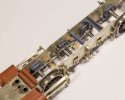Someone asked for some details on the inside motion and how it all goes together.
The ROD is slightly different from previous inside motion sets I've done, double drop links and over and under eccentric rods to clear the 2nd axle.
You're on your own getting anything like the real thing; so in bearded men in garden shed mode, it's a mish mash of parts nailed together. You need a couple of parts from Laurie Griffin miniatures (LGM), specifically the expansion links (though these are not 100% accurate-later) and the drop links. Unfortunately there's only two drop links on each sprue so you need to buy two sets and bin the rest.
The drop links are universal which means no lower bearing, this allows you to adjust the length to suit your engine. These I cut to length and file a half round slot in the bottom end, then add small lengths of 1.5/1.0 mm OD/ID tube to make the lower bearings. The expansion link only has one bracket to hold a singular drop link, it should have two but what you get is better than nothing. Buried deep down in the frames the lack of bracket isn't that noticeable if you place it closest to the frames.
The other LGM part is the piston rod tail end shaft and clevis, the casting has an offset piston rod (a legacy from MR/LMS slide valve set ups, LGM may do a centrally aligned piston rod but I've not seen or used one yet) so it needs cutting off, the shaft drilling out centrally and a new piston rod fitting.
You also need some new etched eccentric rods with forked ends, the forked end is offset 60/40 so you need to make sure the offset are correct to get the expansion link to hang straight and true. The main bearing has a enlarged boss on one side, that needs to be opposite the fork offset.
Finally some bespoke eccentric sheaves and etched overlays with cosmetic ribs and webs hold the eccentric rods in place. a quick test fit shows it clears the 2nd axle and all hangs straight.
Next step is the weight shaft arms (again with small bore tube bearings) and counter balance arm with weight. the arms can now be measured to fit exactly between the drop links and weight shaft in the frames. After that I'll have an accurate position for the piston rod clevis and bearing shaft, then the motion bracket can be made and fitted.






























